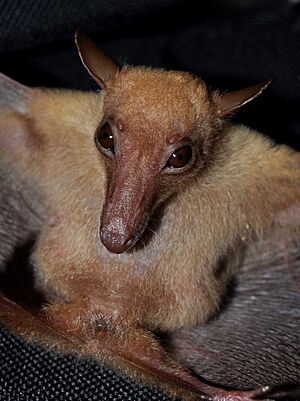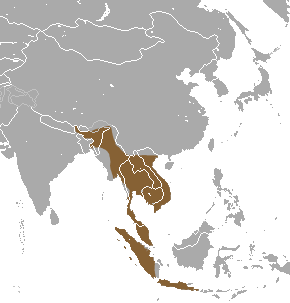Long-tongued fruit bat facts for kids
Quick facts for kids Long-tongued fruit bat |
|
|---|---|
 |
|
| Conservation status | |
| Scientific classification | |
| Genus: |
Macroglossus
|
| Species: |
sobrinus
|
 |
|
| Long-tongued fruit bat range | |
| Synonyms | |
|
|
The long-tongued fruit bat (Macroglossus sobrinus) is a fascinating type of bat. It's known for its long tongue, which helps it drink nectar from flowers, especially banana blossoms! This special bat lives in many countries across South and Southeast Asia.
Contents
Meet the Long-Tongued Fruit Bat
These bats are part of a group called megabats, which are generally larger than other bats. Unlike many bats that eat insects, the long-tongued fruit bat is a nectarivore. This means its main food is nectar, a sweet liquid found in flowers. Think of them as the hummingbirds of the bat world!
How This Bat Got Its Name
This bat was first described in 1911 by a Danish scientist named Knud Andersen. He first thought it was a type of subspecies, which is like a special group within a species. He named it Macroglossus minimus sobrinus.
Later, around 1983, scientists decided it was different enough to be its own full species. The name "sobrinus" means "cousin" in Latin. Andersen might have chosen this name because he thought it was closely related to another bat, M. minimus minimus.
What Does It Look Like?
The long-tongued fruit bat is a bit bigger than some of its bat relatives. It has a longer snout, which is perfect for reaching deep into flowers.
- Its forearm, from elbow to wrist, is about 42 to 48.5 millimeters (1.65 to 1.91 inches) long.
- These bats usually weigh between 18 and 26 grams (0.63 to 0.92 ounces). That's about the weight of a few strawberries!
Life and Habits of the Bat
The long-tongued fruit bat is a nocturnal animal. This means it is active at night, searching for food. During the day, it rests or "roosts" in trees.
- It mostly eats nectar from banana flowers.
- These bats usually roost alone or in small, spread-out groups. They don't typically huddle together in large colonies like some other bats.
Where Do These Bats Live?
Unlike some bats that prefer to live near the coast, the long-tongued fruit bat likes to live more inland. You can find them in many Asian countries, including:
Is This Bat Safe?
Good news! The long-tongued fruit bat is currently listed as a least-concern species by the IUCN. This means that, for now, there are plenty of them, and they are not considered to be in danger of disappearing. It's the lowest level of concern for a species' survival.


